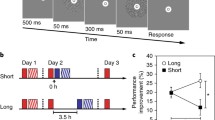Abstract
There is strong evidence that a restricted part of the chick forebrain, the IMM (formerly IMHV), stores information acquired through the learning process of visual imprinting. Twenty-four hours after imprinting training, a learning-specific increase in amount of myristoylated, alanine-rich C-kinase substrate (MARCKS) protein is known to occur in the homogenate fraction of IMM. We investigated the two components of this fraction, membrane-bound and cytoplasmic-phosphorylated MARCKS. In IMM, amount of membrane-bound MARCKS, but not of cytoplasmic-phosphorylated MARCKS, increased as chicks learned. No changes were observed for either form of MARCKS in PPN, a control forebrain region. The results indicate that there is a learning-specific increase in membrane-bound, non-phosphorylated MARCKS 24 h after training. This increase might contribute to stabilization of synaptic morphology.


Similar content being viewed by others
Abbreviations
- ANOVA:
-
Analysis of variance
- Df:
-
Degrees of freedom
- MARCKS:
-
Myristoylated alanine-rich C-kinase substrate
- m-MARCKS:
-
Membrane-associated MARCKS
- cp-MARCKS:
-
Cytoplasmic-phosphorylated MARCKS
- IMM:
-
Intermediate and medial mesopallium
- P :
-
Probability
- PKC:
-
Protein kinase C
- PPN:
-
Posterior pole of the nidopallium
- SEM:
-
Standard error of the mean
References
Aderem A (1992) The MARCKS brothers—a family of protein kinase C substrates. Cell 71:713–716
Arbuzova A, Schmitz AAP, Vergeres G (2002) Cross-talk unfolded: MARCKS proteins. Biochem J 362:1–12
Bolhuis JJ (1991) Mechanisms of avian imprinting: a review. Biol Rev 66:303–345
Bolhuis JJ, Cook S, Horn G (2000) Getting better all the time: improving preference scores reflect increases in the strength of filial imprinting. Anim Behav 59:1153–1159
Bradley P, Horn G, Bateson P (1981) Imprinting: an electron microscopic study of chick hyperstriatum ventrale. Exp Brain Res 41:115–120
Bredenkotter M, Braun K (1997) Changes of neuronal responsiveness in the mediorostral neostriatum/hyperstriatum after auditory filial imprinting in the domestic chick. Neuroscience 76:355–365
Calabrese B, Halpain S (2005) Essential role for the PKC target MARCKS in maintaining dendritic spine morphology. Neuron 48:77–90
Fifkova E, Morales M (1992) Actin matrix of dendritic spines, synaptic plasticity, and long-term potentiation. Int Rev Cytol 139:267–307
Horn G (1985) Memory, imprinting and the brain. Oxford University Press, Oxford
Horn G (1991) Technique for removing IMHV from the chick brain. In: Andrew RJ (ed) Neural and behavioural plasticity. The use of the domestic chick as a model. Oxford University Press, Oxford, pp 44–48
Horn G (2004) Pathways of the past: the imprint of memory. Nat Rev Neurosci 5:108–120
Horn G, Bradley P, McCabe BJ (1985) Changes in the structure of synapses associated with learning. J Neurosci 5:3161–3168
Johnston AN, Rogers LJ, Dodd PR (1995) [H3]MK-801 binding asymmetry in the IMHV region of dark-reared chicks is reversed by imprinting. Brain Res Bull 37:5–8
Matus A (2005) MARCKS for maintenance in dendritic spines. Neuron 48:4–5
McNamara RK, Hussain RJ, Simon EJ, Stumpo DJ, Blackshear PJ, Abel T, Lenox RH (2005) Effect of myristoylated alanine-rich C kinase substrate (MARCKS) overexpression on hippocampus-dependent learning and hippocampal synaptic plasticity in MARCKS transgenic mice. Hippocampus 15:675–683
McNamara RK, Stumpo DJ, Morel LM, Lewis MH, Wakeland EK, Blackshear PJ, Lenox RH (1998) Effect of reduced myristoylated alanine-rich C kinase substrate expression on hippocampal mossy fiber development and spatial learning in mutant mice: transgenic rescue and interactions with gene background. Proc Natl Acad Sci USA 95:14517–14522
Meberg PJ, McCabe BJ, Routtenberg A (1996) Marcks and protein f1/gap-43 messenger-RNA in chick brain—effects of imprinting. Molecular Brain Research 35:149–156
Newton AC, Johnson JJ (1998) Protein kinase C: a paradigm for regulation of protein function by two membrane-targeting modules. BioChim Biophys Acta Rev Biomembranes 1376:155–172
Ouimet CC, Wang JKT, Walaas SI, Albert KA, Greengard P (1990) Localization of the Marcks (87-kda) protein, a major specific substrate for protein kinase-C, in rat-brain. J Neurosci 10:1683–1698
Ramakers GM, McNamara RK, Lenox RH, De Graan PN (1999) Differential changes in the phosphorylation of the protein kinase C substrates myristoylated alanini-rich C kinase substrate and growth associated protein 43/B-50 following Schaffer collateral long-term potentiation and long-term depression. J Neurochem 73:2175–2183
Reiner A et al (2004) Revised nomenclature for avian telencephalon and some related brainstem nuclei. J Comp Neurol 473:377–414
Sheu FS, McCabe BJ, Horn G, Routtenberg A (1993) Learning selectively increases protein kinase C substrate phorphorylation in specific regions of the chick brain. Proc Natl Acad Sci USA 90:2705–2709
Sluckin W (1972) Imprinting and early learning. Methuen, London
Snedecor GW, Cochran WG (1989) Statistical methods. Iowa State University Press, Ames
Solomonia RO, McCabe BJ, Horn G (1998) Neural cell adhesion molecules, learning and memory. Behav Neurosci 112:646–655
Solomonia RO, Morgan K, Kotorashvili A, McCabe BJ, Jackson AP, Horn G (2003) Analysis of differential gene expression supports a role for amyloid precursor protein and a protein kinase C substrate (MARCKS) in long-term memory. Eur J Neurosci 17:1073–1081
Stumpo DJ, Graff JM, Albert KA, Greengard P, Blackshear PJ (1989) Molecular-cloning, characterization, and expression of a cDNA encoding the 80-kda to 87-kda myristoylated alanine-rich c-kinase substrate—a major cellular substrate for protein kinase C. Proc Natl Acad Sci USA 86:4012–4016
Swierczynski SL, Blackshear PJ (1995) Membrane association of the myristoylated alanine-rich C kinase substrate (MARCKS) protein. J Biol Chem 270:13436–13445
Thelen M, Rosen A, Nairn AC, Aderem A (1991) Regulation by phosphorylation of reversible association of a myristoylated protein-kinase-c substrate with the plasma-membrane. Nature 351:320–322
Acknowledgments
We are grateful to the Royal Society and the BBSRC for financial support and to Drs. P. J. Blackshear and D. J. Stumpo, National Institute of Environmental Health Sciences, Duke University, USA for the gift of anti-MARCKS antibody.
Author information
Authors and Affiliations
Corresponding author
Rights and permissions
About this article
Cite this article
Solomonia, R.O., Apkhazava, D., Nozadze, M. et al. Different forms of MARCKS protein are involved in memory formation in the learning process of imprinting. Exp Brain Res 188, 323–330 (2008). https://doi.org/10.1007/s00221-008-1428-3
Received:
Accepted:
Published:
Issue Date:
DOI: https://doi.org/10.1007/s00221-008-1428-3




